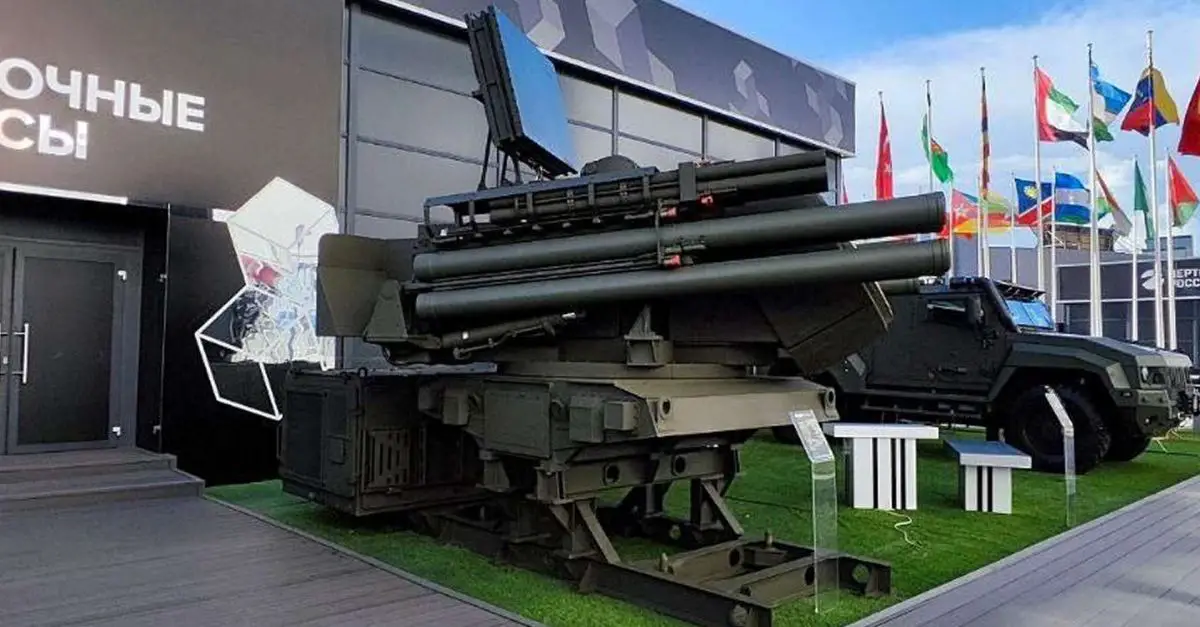Breaking News
Russia presents new Pantsir-SMD-E air defense missile system without 30 mm guns at Army-2024.
At the Army-2024 exhibition, Tula KBP, a subsidiary of Rostec, introduced a new version of the Pantsir air defense missile and gun system, named Pantsir-SMD-E. This iteration differs from previous models primarily due to the removal of 30mm automatic guns and the focus on anti-aircraft missiles of various calibers. The Pantsir-SMD-E is composed solely of a combat module, a design adjustment intended to address both large targets and smaller drones.
Follow Army Recognition on Google News at this link

The exclusion of the 2A38(M) 30 mm automatic cannons in favor of a missile-only system was influenced by experiences during the ongoing conflict in Ukraine, where the limitations of automatic cannons became apparent. (Picture source: Russian social media)
Vladimir Artyakov, deputy head of Rostec, explained that the Pantsir-SMD-E is designed with modularity in mind, allowing it to be deployed on various platforms, including stationary setups. This design choice aims to make the system adaptable to different operational environments. The exclusion of the 2A38(M) 30 mm automatic cannons in favor of a missile-only system was influenced by experiences during the ongoing conflict in Ukraine, where the limitations of automatic cannons became apparent.
One of the key features of the Pantsir-SMD-E is its modular design, which allows for deployment on a variety of platforms, including stationary positions. This adaptability makes the system suitable for a wide range of operational environments. The system's radar capabilities have been enhanced with the addition of a J- or Ka-band detection radar utilizing Active Phased Array Radar (AFAR) technology. This radar can detect small drones with ultra-low Effective Optical Pass (EOP) at ranges of 5-7 kilometers and larger targets, such as 122 mm rockets, up to 10 kilometers. Additionally, the radar system is capable of detecting targets with a radar cross-section (RCS) of 1.0 m² at a maximum range of 45 kilometers.
For target tracking and acquisition, the Pantsir-SMD-E includes a 10ES1 multispectral optical-electronic system to manage a fourth target channel, enhancing its capability to detect and intercept aerial threats. The system continues to use the 3-channel 1RS-2 "Helmet" radar for target acquisition and tracking, although there are plans to replace it with the 1RS-3 radar, which is based on reflective phased array technology.

A significant development in this version of the Pantsir system is the inclusion of up to 48 TKB-10-55 short-range interception mini-missiles, housed in five new quadruple TKB-1056 containers, to engage targets at ranges between 500 and 7,000 meters, and at altitudes ranging from 15 to 5,000 meters. (Picture source: Russian social media)
Therefore, the Pantsir-SMD-E can simultaneously track and engage up to 40 targets, providing a robust defense capability against multiple incoming threats. The standard armament configuration of the Pantsir-SMD-E includes five 57E6 surface-to-air missiles (SAMs) and 20 smaller 19Ya6 missiles, with the option to carry up to 12 transport and launch containers. A significant development in this version is the inclusion of TKB-10-55 short-range interception mini-missiles, which are housed in five new quadruple TKB-1056 containers.
These mini-missiles are specifically designed to target small drones and can engage targets at ranges between 500 and 7,000 meters, and at altitudes ranging from 15 to 5,000 meters. The system can carry up to 48 TKB-10-55 missiles, providing substantial firepower for drone defense. A diesel generator is mounted on the frame behind the launcher, providing the system with the capacity for independent operation.
Since the beginning of the conflict in Ukraine, Russia has expanded its air defense infrastructure, including the construction of fortified embankments and towers, and the relocation of various Pantsir systems to reinforce defenses in the Moscow region. This has occurred amid ongoing aerial attacks on Russian military air force bases by Ukrainian drones. The compactness of the Pantsir-SMD-E allows for possible installation on the roofs of state buildings, such as the Ministry of Defense in Moscow, and for it to replace existing Pantsir systems currently deployed on Pantsir towers.


























